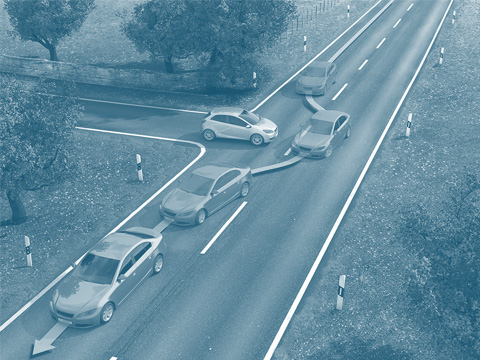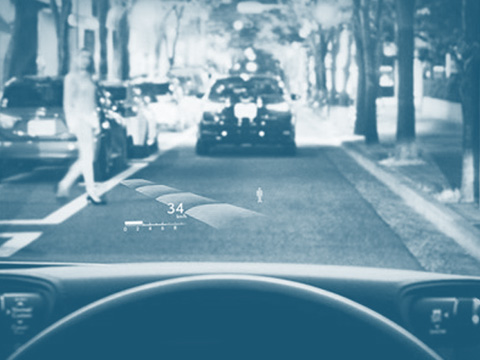Emergency braking systems
Emergency braking systems are an advanced development of driver-assistance systems which control the distance to other vehicles.
Function
Emergency braking systems are intended to help avoid collisions by being able to detect critical proximity to moving or stationary vehicles ahead – in addition to pedestrians – and prepare the brake system for possible emergency braking. This makes full braking power available sooner. Today’s emergency braking systems work in multiple phases to increase safety – including where this involves preventing accidental deployment:
WARNING
If the driver fails to react to a dangerous situation, the system warns the driver with an acoustic or visual signal, followed by a brief yet clearly noticeable jerk in the brakes.PARTIAL BRAKING
The emergency braking system subsequently initiates partial braking to reduce speed and give the driver sufficient time to react. As soon as the driver presses the brake pedal, the system provides braking assistance. To do so, it continuously calculates how rapidly the vehicle must be decelerated to prevent the collision. If the system detects that the driver is not braking sufficiently rapidly, it increases the braking pressure as required to ensure that the vehicle comes to a standstill before hitting the obstacle wherever possible.EMERGENCY BRAKING
However, if the driver does not react to a critical situation where a collision might occur and the predictive emergency braking system detects that such a collision is inevitable, it can automatically initiate emergency braking in combination with a video camera.Emergency braking system variants
EMERGENCY BRAKING SYSTEM FOR URBAN AREAS
Many collisions occur at speeds of less than 30 km/h, such as when driving through the inner city or in slow-moving traffic. Emergency braking systems designed for urban use thus generally operate at up to 30 km/h. In this speed range, collisions can often be avoided through automatically initiated emergency braking.
Emergency braking assist systems for urban driving monitor the area immediately in front of the vehicle using an infrared sensor which is designed for close range (approx. 10 metres), or alternatively with a radar sensor or video camera. The driver is warned as soon as an obstacle has been detected. At the same time, the brake system is prepared. If the driver’s reaction is not adequate, autonomous emergency braking is initiated.
EMERGENCY BRAKING SYSTEM FOR HIGHER SPEEDS
Emergency braking systems for higher speeds are based on the radar systems or cameras that are utilised in adaptive distance control systems.
The system continuously records the distance from vehicles in front, in addition to the relative difference in speed. If the emergency braking system detects a critical proximity to a vehicle driving in front at a speed of more than 30 km/h, it prepares the brake system for a potential emergency braking manoeuvre. However, if the driver does not react to a critical situation where a collision might occur, and if the predictive emergency braking system detects that such a collision is inevitable, it can automatically initiate emergency braking. As a result, the vehicle will be travelling considerably more slowly at the point of impact, and the risks are reduced.
Safety
Emergency braking systems make a vital contribution to road safety. In doing so, they help motorists avoid collisions altogether, or at least considerably reduce the impact speed in the event of a collision, thereby reducing the severity of an accident. According to accident research conducted by Bosch, up to 72 per cent of all collisions resulting in injury in Germany alone could be avoided if all vehicles were equipped with an automatic, on-board emergency braking system.








